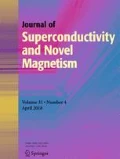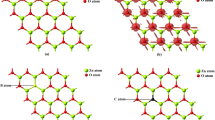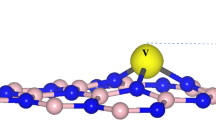Abstract
We have investigated the electronic structure and magnetic properties of cobalt (Co)- or nickel (Ni)-doped hexagonal boron nitride (h-BN) monolayer using density functional theory calculations. The h-BN monolayer without any doping is a nonmagnetic insulator. Our studies show that isolated Co or Ni atom can both induce the local magnetic state in h-BN monolayer. And the impurity energy levels will be formed in the band gap. Results of our first-principle calculations reveal that isolated Co atom can result in a magnetic moment of 3.57 μ B, while the Ni atom is 0.87 μ B. And the magnetic moments mainly come from d orbitals of the doped atoms. The studies of magnetic coupling show that the two Co atoms at different distances in h-BN monolayer do not always couple ferromagnetically. When the distances are 2.504 and 6.625 Å, the spins induced by the two Co atoms will form antiferromagnetic ground states. While the two Ni atoms at different distances in the monolayer always couple ferromagnetically. So our results imply that the Ni-doped h-BN is more suitable for spintronic material than Co doping. These results are useful for spintronic application.









Similar content being viewed by others
References
Fert, A.: Nobel lecture: origin, development, and future of spintronics. Rev. Mod. Phys. 80(4), 1517–1530 (2008)
Z̆utić, I., Fabian, J., Sarma, S.D.: Spintronics: fundamentals and applications. Rev. Mod. Phys. 76 (2), 323–410 (2004)
Wadley, P., Howells, B., Z̆elezný, J., Andrews, C., Hills, V., Campion, R.P., Novák, V., Olejník, K., Maccherozzi, F., Dhesi, S.S., Martin, S.Y., Wagner, T., Wunderlich, J., Freimuth, F., Mokrousov, Y., Kunes̆, J., Chauhan, J.S., Grzybowski, M.J., Rushforth, A.W., Edmonds, K.W., Gallagher, B.L., Jungwirth, T.: Electrical switching of an antiferromagnet. Science 351(6273), 587–590 (2016)
Zhou, J., Wang, Q., Sun, Q., Jena, P.: Electronic and magnetic properties of a BN sheet decorated with hydrogen and fluorine. Phy. Rev. B. 81(085442), 1–7 (2010)
Azevedo, S., Kaschny, J.R., de Castilho, C.M.C., de Brito Mota, F.: Corrigendum: theoretical investigation of native defects in a boron nitride monolayer. Nanotechnology 18(495707), 1–4 (2007)
Jin, C., Lin, F., Suenaga, K., Iijima, S.: Fabrication of a freestanding boron nitride single layer and its defect assignments. Phys. Rev. Lett. 102(195505), 1–4 (2009)
Blase, X., Rubio, A., Louie, S.G., Cohen, M.L.: Stability and band gap constancy of boron nitride nanotubes. Europhys. Lett. 28(5), 335–340 (1994)
Rubio, A., Corkill, J.L., Cohen, M. L.: Theory of graphitic boron nitride nanotubes. Phys. Rev. B. 49 (7), 5081–5084 (1994)
Novoselov, K.S., Geim, A.K., Morozov, S.V., Jiang, D., Zhang, Y., Dubonos, S.V., Grigorieva, I.V., Firsov, A.A.: Electric field effect in atomically thin carbon films. Science 306(22), 666–669 (2004)
Greber, T.: Graphene and hexagonal boron nitride layers: nanostructures with 3 bond hierarchy levels. e-J. Surf. Sci. Nanotech. 8, 62–64 (2010)
Molla, M., Behbahani, T.J.: Adsorption of N2, O2, CO, and CO2 on open ends and surface of single wall carbon nano-tubes: a computational nuclear magnetic resonance and nuclear quadrupole resonance study. J. Mol. Liq. 222, 717–732 (2016)
Zhang, Z.F., Zhou, T.G., Zuo, X.: First-principles calculations of h-BN monolayers by doping with oxygen and sulfur. Acta. Phys. Sin. 62(8), 1–7 (2013)
Wu, R.Q., Liu, L., Peng, G.W., Feng, Y.P.: Magnetism in BN nanotubes induced by carbon doping. Appl. Phys. Lett. 86(122510), 1–3 (2005)
Ooi, N., Rairkar, A., Lindsley, L., Adams, J.B.: Electronic structure and bonding in hexagonal boron nitride. J. Phys.: Condens. Matter. 18, 97–115 (2006)
Azevedo, S., Kaschny, J.R., de Castilho, C.M.C., de Brito Mota, F.: Electronic structure of defects in a boron nitride monolayer. Eur. Phys. J. B. 67, 507–512 (2009)
Matos, M.J.S., Chacham, H.: Graphene-boron nitride superlattices: the role of point defects at the BN layer. Nanotechnology 25(165705), 1–6 (2014)
Kresse, G., Furthmüller, J.: Efficient iterative schemes for ab initio total-energy calculations using a plane-wave basis set. Phys. Rev. B. 54(16), 11169–11186 (1996)
Kresse, G., Joubert, D.: From ultrasoft pseudopotentials to the projector augmented-wave method. Phys. Rev. B. 59(3), 1758–1775 (1999)
Perdew, J.P., Burke, K., Ernzerhof, M.: Generalized gradient approximation made simple. Phys. Rev. Lett. 77(18), 3865–3868 (1996)
Pei, G., Xia, C., Wu, B., Wang, T., Zhang, L., Dong, Y., Xu, J.: Studies of magnetic interactions in Ni-doped ZnO from first-principles calculations. Comput. Mater. Sci. 43, 489–494 (2008)
Acknowledgments
This work was supported by Science and Technology Research Project of Hebei higher education, China (grant no. ZD2016042) the Natural Science Foundation of Hebei, China (grant no. F2017208031), and the Natural Science Foundation of China (grant no. 51674096)
Author information
Authors and Affiliations
Corresponding author
Rights and permissions
About this article
Cite this article
Wang, M., Tang, S., Ren, J. et al. Magnetism in Boron Nitride Monolayer Induced by Cobalt or Nickel Doping. J Supercond Nov Magn 31, 1559–1565 (2018). https://doi.org/10.1007/s10948-017-4353-5
Received:
Accepted:
Published:
Issue Date:
DOI: https://doi.org/10.1007/s10948-017-4353-5




